Espiritu Santo Revisited
by Dorothy Mizer
View the entire
Mizer Photo Album
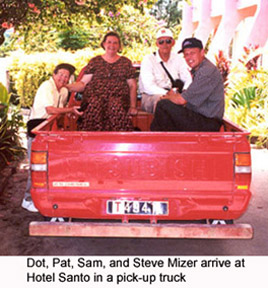 Trip to New Zealand and the Vanuatu Islands from December 18, to January 5, 1999 by Sam and Dorothy Mizer with their son Steven and his wife Patti Mizer. Being 75 years old didnít stop Sam and Dot - on with the trip. The weather was ideal the whole trip with only a couple of rain showers - no storms.
Trip to New Zealand and the Vanuatu Islands from December 18, to January 5, 1999 by Sam and Dorothy Mizer with their son Steven and his wife Patti Mizer. Being 75 years old didnít stop Sam and Dot - on with the trip. The weather was ideal the whole trip with only a couple of rain showers - no storms.
Sam always wanted to go back to Espiritu Santo. the largest of the Vanuatu Islands (formerly New Hebrides). He was stationed on Santo for 14 months, from December 1942 until January 1944. Sam was photographer with VMD-154 Marine Photographic Squadron, comprised of 20 officers and 405 enlisted men. Their job was to fly over enemy territory, take pictures of sites to be bombed, come back and develop the pictures which gave the pilots up-to-date information and maps of the territory. The pictures were taken from the big B-24 bombers. Their camp was called Camp Elrod.
We had a great trip and made every connection - 17 airplane boardings - with just one near miss. Our family stayed overnight in Los Angeles on both the outbound and return flights. We met with fellow Marine Bud Bortz, talked with squadron member George Brown on the phone, and visited with relatives. This gave us a welcome break in the long trip.
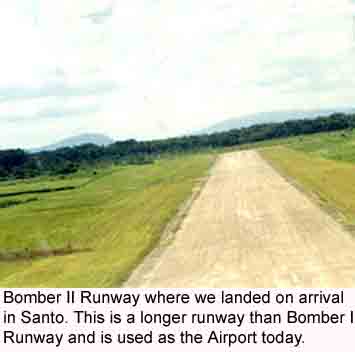
December 19, 1998
- At 10:30 PM, we left LA for Auckland, New Zealand. Traveling business class was a real treat. We used our sonís frequent flier tickets for this part of the journey. This entitled us to use the red carpet room at L.A., Auckland, and Chicago to wait for our flights. With such good food and service, we may never be able to go back to ordinary flying again! The trip to New Zealand was over 12 hours but it was such pleasure with the reclining seats, foot rests, meals, movies, watching the monitor to see how far the plane had flown, etc. They gave us thick socks to wear so everyone took their shoes off.
December 21,
Monday (we lost Sunday) - We arrived in Auckland at 8:00 AM and spent the day touring the city. We went to Victoria Park where Sam had stayed in a hut in 1943 after getting out of the hospital in Auckland. He had jaundice so they sent him there to recover. It took about two months for him to get back to Santo. He actually wasnít in the hospital long; it just took awhile to get back to Santo. Sam doesnít remember the hills being so steep in Auckland. We said maybe it is because you are not 19 years old anymore.
We went up the Sky Tower, tallest structure in the southern hemisphere. We continued with a geology tour around Auckland. The guide was very interesting. He showed us the former location of the hospital where Sam had been a patient. The guide was born there in 1949, and the hospital later burned down.

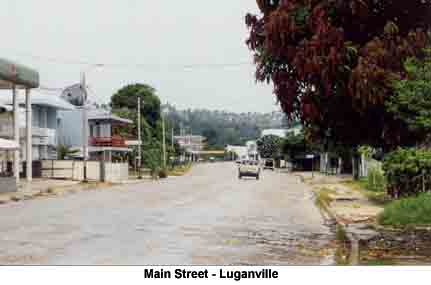
December 22,
Tuesday - After staying overnight in Auckland, we flew to Port Vila, Efate Island, one of the Vanuatu Islands. We stayed overnight there, then got a smaller plane to Santo.
December 23,
Wednesday - We were surprised when we landed on Espiritu Santo. The transportation to our hotel was in a pick-up truck, with a bench in the back to sit on. Most people use pick-ups there, and we did have a couple of tours in Land Rover vans. The roads are very bumpy. The natives say Santo needs to have the Americans come back and fix their roads again.
Hotel Santo is really nice. Right on Main Street in Luganville, it has a swimming pool and a flower garden in the back yard where they picked flowers every day for the hotel rooms and lounge area. Luganville, however, is a lazy, down-at-heel sort of place. Numerous, aging quonset huts and cement slabs show evidence of busier times. A lot of stores seemed to be run by Chinese. The natives are mostly Melanesians. The tranquility of this island and the friendly people with their preserved customs made our stay a very relaxing time. The coconut grapevine told everyone there was an old U.S. Marine back in town, so when we went down the street the little kids would salute us.
The women mostly wear long dresses. They are considered second class citizens by the men. The guides speak English fairly well, but they have their own pidgin form or Bislama language. There are approximately 10,000 people in Luganville. We were in Santo from Wednesday, December 23 to Sunday, December 27.
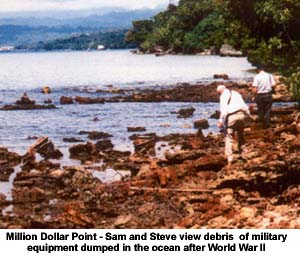
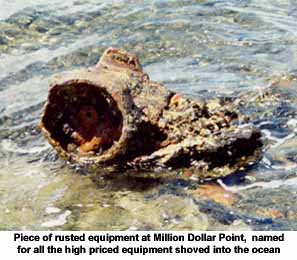
December 24,
Thursday - Glen, our guide, took us to Million Dollar Point where military equipment was dumped after World War II. When the U.S., the Santo government, and local French planters couldn't reach an agreement on salvage price, the Americans dumped everything from bulldozers, aero engines, trucks and jeeps to crates of Coca-Cola, clothing and canned food into the ocean. We brought home a broken Coke bottle that was wahed up on the beach. You can still see parts of engines, etc. It is truly sad. We also saw the site where the SS Coolidge sank.
We then went to the Bomber One Airstrip. It is mostly overgrown, but you can see portions of coral. We dug a bolt out of the airstrip that probably came off an aircraft, as it had a hole for a keeper wire through it. The guide said the reason Bomber One was so overgrown is because it was built in such a hurry so that supplies could be flown in. Fighter Strip runway is in pretty good shape. We drove down it.
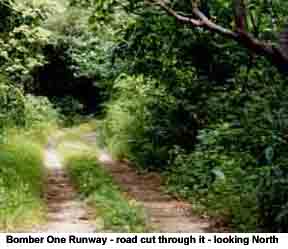

Our guides didn't know where Camp Elrod was located. Our first guide had his own agenda - he showed us Bloody Mary's hut and gave a long story about her doings. It was interesting, but Sam wanted to find Camp Elrod.
We drove through some coconut groves and cattle pastures, but the lay of the land wasn't just right. We gave up for the day. It was interesting to note that the islanders were using the old landing mats from the airstrips as railings for their small bridges. They also used them in the copra driers where coconut flesh is dried, probably for other things that we didn't come across.
Sam thinks the beach looked familiar at one point where long ago he had walked out and gathered shells, but where is Camp Elrod?
December 25,
Friday, Christmas - Our guide took us to the golf course. He told Pat and Dot to stand back behind a building while he walked up to the golf course caretaker. After that the whole family came out, and we visited. Sam was almost convinced that the golf course was the site of Camp Elrod. It had a banyan tree, some cement foundations, etc., but it still wasn't uphill enough from the ocean. So, we moved on to the field beside the course where we had been the day before. It was midday and very hot out in the cattle field and cocomut grove. Pat and Dot finally stood under a tree which was much cooler with the ocean breeze. After awhile, Sam and the guide came back and asked where Steve was. Oh no - we lost Steve in the jungle!
Continued on Page 2

 Trip to New Zealand and the Vanuatu Islands from December 18, to January 5, 1999 by Sam and Dorothy Mizer with their son Steven and his wife Patti Mizer. Being 75 years old didnít stop Sam and Dot - on with the trip. The weather was ideal the whole trip with only a couple of rain showers - no storms.
Trip to New Zealand and the Vanuatu Islands from December 18, to January 5, 1999 by Sam and Dorothy Mizer with their son Steven and his wife Patti Mizer. Being 75 years old didnít stop Sam and Dot - on with the trip. The weather was ideal the whole trip with only a couple of rain showers - no storms.



